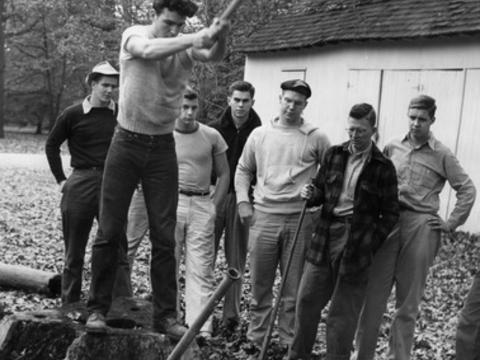Connecting to Nature at Haverford College: A History
Photograph of 7 students working on the HCA Garden in June 2021. Photograph courtesy of Haverfarm.
Details
In this blog post, Maia Schwallie '25 traces the Haverford community's connection to nature through campus work from the College's beginnings to the present day. Maia works in Quaker & Special Collections as a Documenting Student Life Project student liaison.
It is not difficult for current Haverford students to get involved with nature on campus. Students can muddy their knees on Haverfarm work days, plant shrubs with the Arboretum, or simply take a nice stroll between trees on the nature trail. Haverford’s connection to nature is potent, and a dive into our college’s history can show us why a relationship to the natural world is still such a strong tenet of our community.
In 1833, soon after purchasing the land on which Haverford sits, trees were one of the first things on the Board of Managers’ minds. Even before constructing buildings to populate the campus, the Managers planted an orchard, consisting of “60 varieties of apples, 100 assorted peaches, 24 assorted plums, 20 Sickel pears, 10 St. Germain pears, and 18 assorted winter pears” (Campus Club notebook). The managers also employed English gardener William Carvill to design the college’s landscape in 1834. Of the original 495 trees Carvill planted, the Haverford College Arboretum believes a few still stand on campus today.
At the inception of the College, many students were invested in maintaining and contributing to the landscape Carvill created. The Loganian Society, Haverford’s first and longest student-run organization, erected their own botanical garden in 1834 and a student committee on botany and zoology overlooked the grounds. In 1838, students helped raise 3,000 dollars to build a “new and enlarged” greenhouse. Though that greenhouse burned down in a fire in 1855, you can still see remnants of the structure, now called “Carvill Arch,” outside Lutnick library. Today, Haverford is home to three greenhouses in use by the Haverfarm, the Arboretum, and the Biology Department.
In 1901, students, alumni, faculty, and friends of the College founded an organization called The Campus Club. The Campus Club intended to improve and preserve Carvill’s original landscape, catalog rare trees and shrubs on campus, spur interest in ornithology, and promote a general passion for forestry. The Campus Club succeeded in their missions, and today you can find many of their materials preserved in the College Archives, including lists of trees on campus in the 20th century, publications produced by the Campus Club, plans for revitalizing the duck pond, and correspondence between members of the club, among other fascinating items.
In 1948, the Campus Club held the first ever “Campus Day,” an annual, full-day event in which students and community members gathered to help beautify the college campus. Students and community members were split into groups to tackle different areas of the college that needed to be cleaned up or improved. Records from the 1949 Campus Day event show students raked leaves, helped conserve soil, laid brick, cleaned up trash, and labeled trees, among other beautification tasks.
Campus Day likely inspired the Campus Work Days that were held twice a year in the 1980s and 1990s. These work days were very similar to Campus Days, since their goal was to maintain and improve the campus by working together as a community. Campus Work Days usually occurred on a Saturday or Sunday, with one work day during Customs Week and another in mid-spring. The event would culminate in some sort of celebration, such as sports games, a dance, or a barbecue. Rather than sponsored by the Campus Club, which disbanded in the 1960s, these Campus Work Days were funded and organized by Students’ Council, the Work Program, and the Arboretum.
The Haverford College Arboretum is one of the organizations at Haverford that most supports the relationship between students and nature. Founded in 1974, by John A. Silver (Class of 1925), the Arboretum is a staple of life at Haverford. Student involvement in the Arboretum has been especially important to the maintenance of the organization over the years, and the Arboretum was one of the main supporters of the creation of the Haverfarm.
Founded by Andrew Bostick (Class of 2012) in 2010, the Haverfarm has been promoting student connection to the land for over a decade. Today, the Haverfarm is home to a greenhouse, an apiary, a classroom, a high tunnel, community garden plots, and beds located at the farm and in the Haverford College Apartments (HCA) garden. At its inception, the farm lived in a few temporary raised beds in HCA and was tended to by the Farm Club. The farm has grown a lot since 2010, not only physically, but in the programs it offers as well. Through programs like Haverfarm PE, weekly volunteer hours, and workshops in the Haverfarm classroom, the Haverfarm continually succeeds in helping Haverford students learn more about caring for and respectfully using the land around them.
From William Carvill to the Campus Club to Campus Work Days, the Arboretum, and the Haverfarm, Haverford is clearly devoted to living harmoniously with the land around it.
Citation:
Haverford College Campus Club records (HCQ.003.021) Quaker and Special Collections, Haverford College, Haverford, PA.









